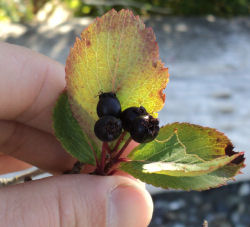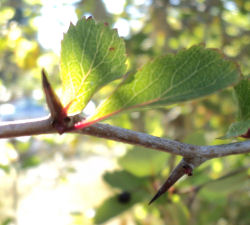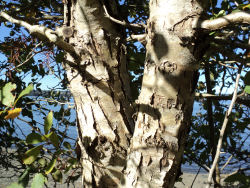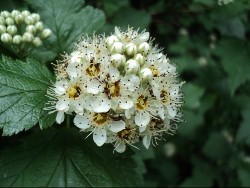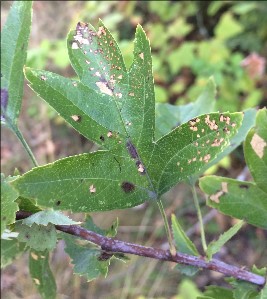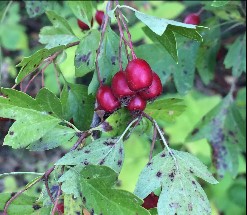|
|
|
|
|
|
| Practical ecological knowledge for the temperate reader. |
Crataegus Sp. - Hawthorn
Family: Rosaceae - (Rose family) [E-flora]
"Habit: Shrub, tree, thorny. Leaf: simple, alternate, petioled, +- ovate, generally +- lobed above middle, toothed, deciduous. Inflorescence: panicle on short-shoot tips, domed; pedicel bractlets several to many, +- 5 mm, narrow, margins glandular. Flower: hypanthium urn-shaped, bractlets 0; sepals small, margins entire to finely toothed, generally glandular; petals white; stamens +- 10 or 20; ovary inferior, styles 1--5, free. Fruit: pome, drupe-like, red to black, generally lighter in color before fully mature, core of 1--5 laterally pitted stones [or not]; sepals reflexed [or not].
+- 200 species: northern temperate. (Greek: hard, for wood) [Phipps & O'Kennon 2002 Sida 20:115-144] Several species cultivated, escaped." [Jepson]
Local Species;
- Crataegus douglasii - black hawthorn [TSFTK][PCBC][E-flora]
- Crataegus monogyna - common hawthorn [TSFTK][PCBC][E-flora]
Hazards
- "The main adverse effects of Crataegus are dizziness and vertigo (3)."[SEHM]
- Drug Interactions: "Additive effect on cardiac glycosides; increases coronary artery dilating effects of a number of drugs; increases barbiturate induced sleeping times." [BMWH]
Food Use
- Fruit: "Europeans and indigenous Americans are known for eating the fruits of hawthorns - particularly when there is nothing better available. There are records of fruits having been eaten from C. aestivalis, C. crusgalli, C. flava, C. marshallii, C. spathulata, and C. uniflora (Yanovsky 1936, Hocking 1997). Moerman (1998) lists 12 other species whose fruits were eaten across North America." [Daniel F Austin]
Other Use
- Wood: "The wood from all Crataegus is hard and heavy, and it was used by Europeans and Americans. Harrar and Harrar (1946) say that the famous Irish shillelaghs (cudgels) were made from the wood of black hawthorn. In the Americas, at least the wood of C. crusgalli has been used for tool handles (Uphof 1968)." [Daniel F Austin]
Medicinal Use
- Dosage: "CRATAEGUS (Hawthorn) BERRIES, FLOWERING BRANCHES. Tincture [Fresh Plant, 1:2, Dry Berries, 1:5, 60% alcohol] 10-30 drops, to 3X a day. Cold Infusion (berries) 1-2 ounces, to 2X a day." [Moore(1995)]
- Cardiotonic: "whereas others are gentle and generally safe cardiotonics, like Crataegus (hawthorn)" [BMWH]
Uses of Related Sp.
"HAWTHORN BERRIES AND LEAVES (CRATAEGUS MONOGYNA, C. LAEVIGATA, AND RELATED SPECIES) - Dilates coronary arteries, Improves blood flow to the heart, Decreases blood cholesterol levels, Acts as a hypotensive agent, and Improves digestion." [PDBHM]
- Hawthorn (Crataegus Oxyacantha). "Hawthorn leaves, berries, and blossoms contain flavonoids. One of these, proanthocyanidin, has especially good cardiovascular effect. Hawthorn preparations are modestly effective in reducing
blood pressure,323 in the prevention and treatment of atherosclerosis, lowering cholesterol, and preventing the oxidation of LDL.324 Hawthorn preparations improve the blood supply to the heart by dilating the coronary arteries, increase the force of contraction of the heart muscle, and regulate cardiac rhythm." [Hudson WENM]
Fungal Relatioships
"At least three indigenous truffle species with notable culinary value are found in southern and eastern North America...the best known is Tuber lyonii, the pecan or Texas truffle, which is found from central Mexico to southeastern Canada, roughly throughout the eastern third of the continent. Tuber lyonii is associated with several host tree genera, including members of Quercus, Crataegus, Tilia (Trappe et al. 1996), Corylus (Bruhn 2007), and the
pecan tree, Carya illinoinensis (Hanlin et al. 1989). Its fruiting season extends from March to February throughout its geographic range (Trappe et al. 1996), but it appears to vary in different regions." [SoilBio-34]
Crataegus douglasii - Black Hawthorn
- Family: Rosaceae (Rose family) [E-flora]
- Overconsumption, Fruit, Wood, Diarrhoea, Arthritic Pain
"Crataegus douglasii is a deciduous Tree growing to 9 m (29ft 6in).
It is hardy to zone (UK) 5 and is not frost tender. It is in flower in May, and the seeds ripen in September. The flowers are hermaphrodite (have both male and female organs) and are pollinated by Midges.
Suitable for: light (sandy), medium (loamy) and heavy (clay) soils and can grow in heavy clay soil. Suitable pH: acid, neutral and basic (alkaline) soils and can grow in very alkaline soils.
It can grow in semi-shade (light woodland) or no shade. It prefers moist or wet soil and can tolerate drought. The plant can tolerates strong winds but not maritime exposure.
It can tolerate atmospheric pollution."[PFAF]
- SUBTAXA PRESENT IN BC
- Crataegus douglasii var. douglasii
- Crataegus douglasii var. suksdorfii [E-flora]
- Synonyms
- Crataegus columbiana Howell
- Crataegus douglasii var. douglasii Lindl. [superfluous autonym][E-flora]
- C. rivularis. [PFAF]
- "Introduction Black hawthorn is a medium to tall shrub species frequently found in southern British Columbia. It has white flowers with 5 petals that appear in the spring; alternate simple leaves, and straight, stout thorns."[E-flora]
- "General: Medium to tall shrub 1-7 m tall, with stout, straight thorns 1-2 (3) cm long; bark grey or brownish, rough and scaly." [IFBC-E-flora]
- "Habitat / Range Moist to mesic, open rocky slopes, bluffs, streambanks, lakeshores, gullies, thickets, edges of forests in the lowland to montane zones; frequent in S BC north to 56o N; N to S AK, E to ON and S to SD, WY and CA." [IFBC-E-flora] "Open woods, banks of mountain streams and on rocky banks[43, 82]. Western N. America - British Columbia to Michigan, south to California." [PFAF]
- Origin Status: Native [E-flora]
- Notes: Two varieties occur in BC:
- "1. Flowers mostly with 10 stamens; ovaries often hairy; leaves often weakly lobed above the middle as well as saw-toothed; plants from largely east of the Coast-Cascade Mtns., the common variety"................. var. douglasii
- "1. Flowers mostly with 20 stamens; ovaries usually smooth; leaves merely 1- to 2-times saw-toothed; plants from west of the Cascade Mtns"........................ var. suksdorfii Sarg. [IFBC-E-flora]
Ecological Indicator Information
"A shade-tolerant/intolerant, submontane to montane, North American deciduous shrub distributed in the Pacific, Cordilleran, and Central regions. Occurs on very moist to wet, nitrogen-rich soils (Moder and Mull humus forms) within boreal. temperate, cool semiarid, and cool mesothermal climates. Sporadic in opencanopy forests on water-receiving sites, scattered in poorly forested, semi-terrestrial communities on water-collecting sites (swamps). Characteristic of nutrient-rich wetlands." [IPBC-E-flora]
Hazards
- Overconsumption: "The berries have a reputation for causing a stomach ache or constipation if too many are eaten."[Turner, Kuhnlein]
Edible Uses
- Fruit "Raw or cooked[2, 3, 95, 99, 101]."[PFAF]
- Harvesting: "Gathered in late July through the fall."[Turner, Kuhnlein]
- Preparation: "Makes an excellent dessert fruit and can be eaten in quantity[K]. The fruit can also be used for making pies, preserves etc, [183]".[PFAF] "Eaten both fresh and dried. Often eaten with oily foods to relieve some of their dryness."[Turner, Kuhnlein] "The Iroquois ate haws raw, or boiled them whole, cooked them in a sauce or baked them in ashes."[Turner, Kuhnlein] Mashed and dried into thin, hard cakes, which were eaten as a snack, dipped into soup or boiled with deer fat and bone marrow."[Turner, Kuhnlein] "The dry sweetish fruits were eaten by the Island Salish groups, usually in the early fall. The Songish ate them with salmon roe (Boas, 1890)."[Turner&Bell]
- Properties: "There are up to five fairly large seeds in the centre of the fruit, these often stick together and so the effect is of eating a cherry-like fruit with a single seed[K]."[PFAF] "A very pleasant flavour with a sweet and juicy succulent flesh[46, 82, K]"[PFAF]
- Not highly regarded.[Turner, Kuhnlein] "Spitting out the seeds is recommended when eating these berries."[Turner, Kuhnlein]
- Preservation: Can be dried for later use[183].[PFAF] "Dried loosely like raisins, or baked on slabs of wood over the fire."[Turner, Kuhnlein] "Sometimes mixed with pounded, dried salmon bones and flesh. The dried berries were said not to keep well."[Turner, Kuhnlein]
Other Uses
- Needle: "The spines on the branches are used as needles for lancing boils, removing splinters etc[99]."[PFAF]
- Wood: "Wood - close-grained, heavy, hard and tough. Used for tool handles etc[82, 99, 101]."[PFAF]
Medicinal Uses
- Fruit: Eaten for diarrhoea and general sickness.[Turner, Kuhnlein]
- Bark: "An infusion of the bark has been used in the treatment of diarrhoea and dysentery[257]."[PFAF]
- Thorns: "The thorns have been used as a treatment for arthritis[257].The point of the thorn was used to pierce an area affected by arthritic pain. The other end of the thorn was ignited and burned down to the point buried into the skin. This treatment was very painful but it was said that after a scab had formed and disappeared, the arthritic pain had also disappeared[257]. The thorns have been used as probes for boils and ulcers[257]."[PFAF]
- Shoots: "An infusion of the shoots has been used to treat diarrhoea in children and sores in babies mouths[257]."[PFAF]
- Leaves: "A poultice of the chewed leaves has been applied to swellings[257]."[PFAF]
- Sapwood, Bark & Roots: "An infusion has been used as a stomach medicine[257]."[PFAF]
- Heart Tonic: "Although no other specific mention has been seen for this species, the fruits and flowers of many hawthorns are well-known in herbal folk medicine as a heart tonic and modern research has borne out this use. The fruits and flowers have a hypotensive effect as well as acting as a direct and mild heart tonic[222]. They are especially indicated in the treatment of weak heart combined with high blood pressure[222]. Prolonged use is necessary for it to be efficacious[222]. It is normally used either as a tea or a tincture[222]."[PFAF]
Cultivation & Propagation
"A very easily grown plant, it prefers a well-drained moisture retentive loamy soil but is not at all fussy[11, 200]. Once established, it succeeds in excessively moist soils and also tolerates drought[200]. It grows well on a chalk soil and also in heavy clay soils[200]. A position in full sun is best when plants are being grown for their fruit, they also succeed in semi-shade though fruit yields and quality will be lower in such a position[11, 200]. Most members of this genus succeed in exposed positions, they also tolerate atmospheric pollution[200]. Hybridizes freely with other members of this genus[200]. Seedling trees take from 5 - 8 years before they start bearing fruit, though grafted trees will often flower heavily in their third year[K]. The flowers have a foetid smell somewhat like decaying fish. This attracts midges which are the main means of fertilization. When freshly open, the flowers have more pleasant scent with balsamic undertones[245]. Seedlings should not be left in a seedbed for more than 2 years without being transplanted[11]."[PFAF]
"Seed - this is best sown as soon as it is ripe in the autumn in a cold frame, some of the seed will germinate in the spring, though most will probably take another year. Stored seed can be very slow and erratic to germinate, it should be warm stratified for 3 months at 15°c and then cold stratified for another 3 months at 4°c[164]. It may still take another 18 months to germinate[78]. Scarifying the seed before stratifying it might reduce this time[80]. Fermenting the seed for a few days in its own pulp may also speed up the germination process[K]. Another possibility is to harvest the seed 'green' (as soon as the embryo has fully developed but before the seedcoat hardens) and sow it immediately in a cold frame. If timed well, it can germinate in the spring[80]. If you are only growing small quantities of plants, it is best to pot up the seedlings as soon as they are large enough to handle and grow them on in individual pots for their first year, planting them out in late spring into nursery beds or their final positions. When growing larger quantities, it might be best to sow them directly outdoors in a seedbed, but with protection from mice and other seed-eating creatures. Grow them on in the seedbed until large enough to plant out, but undercut the roots if they are to be left undisturbed for more than two years." [PFAF]
Crataegus monogyna - Common Hawthorn
Family: Rosaceae - (Rose family) [E-flora]
Other Names: Oneseed hawthorn.[E-flora]
Caution, Fruit, Flowers, Leaves, Young shoots, Seeds, Wood, Hedge, Diarrhoea, Heart Tonic
Synonyms
Crataegus curvisepala auct. non Lindm. [misapplied]
Crataegus monogyna var. rosea (Willd.) K. Koch
Crataegus oxyacantha auct. non L. [misapplied]
Crataegus oxyacantha var. paulii (Rehd.) Rehd.[E-flora]
Introduction
"Common hawthorn is an introduced invasive shrub or small tree that originates in Europe, west Asia and North Africa (Phipps 1998). It was introduced as a garden plant in North America and is now present in western and eastern regions of the continent (USA: AK, AR, CA, CT, DC, DE, IL, KY, MA, ME, MI, MT, NH, NJ, NY, OH, OR, PA, RI, TN, UT, VA, VT, WA, WI, WV, CAN: BC, NB, NS, ON, PE, QC) (USDA 2010). In BC, common hawthorn is found on southeastern Vancouver Island and the southwestern corner of the mainland, with a few reports from the north coast and the Queen Charlotte Islands. It is frequently encountered in the Fraser delta and is invasive in Garry oak ecosystems on Vancouver Island where it can replace open sites with a dense shrub layer (GOERT 2002). It is locally common at Salmon Arm and Castlegar with sporadic occurrences elsewhere inland (Phipps 1998).
This is generally an easily recognized medium to tall shrub species with distinctive simple lobed leaves, short stout thorns about 1 cm long, white flowers, and red fruit. Morphology can be variable, however, perhaps because of multiple origins and cultivars present in the area (Phipps 1998). The red fruits readily distinguish it from BC's other two species of Crataegus, which are black-fruited, although hybrids with the native black hawthorn (Crataegus douglasii) have been reported (GOERT 2002). The species is readily dispersed by birds." [E-flora]
"Crataegus monogyna is a deciduous Shrub growing to 6 m (19ft) by 6 m (19ft) at a medium rate.
It is hardy to zone (UK) 5 and is not frost tender. It is in flower from May to June, and the seeds ripen from Sep to November. The flowers are hermaphrodite (have both male and female organs) and are pollinated by Midges. It is noted for attracting wildlife.
Suitable for: light (sandy), medium (loamy) and heavy (clay) soils and can grow in heavy clay and nutritionally poor soils. Suitable pH: acid, neutral and basic (alkaline) soils and can grow in very acid and very alkaline soils.
It can grow in semi-shade (light woodland) or no shade. It prefers moist or wet soil and can tolerate drought. The plant can tolerate maritime exposure.
It can tolerate atmospheric pollution."[PFAF]
- "General: Large shrub or small tree 2-10 m tall, with short stout thorns about 1 cm long; twigs greyish to reddish-brown, smooth; bark dark grey-brown, scaly." [IFBC-E-flora]
- "Habitat / Range Moist to mesic disturbed places, thickets, forest margins and open forests in the lowland zone; infrequent in SW BC, rare inland and north along the coast; introduced from Europe." [IFBC-E-flora] "Woods, hedges, thickets etc, on most soils except wet peat and poor acid sands[9, 17]. Europe, including Britain, absent from Iceland, south and west the Mediterranean and Afghanistan." [PFAF]
- Origin Status: Exotic [E-flora]
Caution
- "Accurate diagnosis of stage II congestive heart failure should be obtained prior to use of Folium cum Flore Crataegi. Consult a physician if symptoms worsen, remain unchanged for longer than 6 weeks, or if water accumulates in the legs. Medical attention is absolutely necessary if pain occurs in the region of the heart, spreading out to the arms, upper abdomen or neck area, or in cases of respiratory distress (e.g. dyspnoea) (84)."[WHO]
- "Limited evidence suggests that there may be additive blood pressure-lowering effects if hawthorn is taken with conventional antihypertensives, but the effects are small."[HMI Stockey]
More hazards below under 'Crataegus Sp.'
Edible Uses
- Fruit: Raw or cooked[2, 12].[PFAF][Turner, Kuhnlein]
- Preparation: "Used for making jams and preserves[9, 183]. The fruit can be dried, ground, mixed with flour and used for making bread etc[46]." [PFAF]
- Properties: "Not very appetizing raw[9, K]. There are up to five fairly large seeds in the centre of the fruit, these often stick together and so the effect is of eating a cherry-like fruit with a single seed[K]." [PFAF]
- Young Shoots: "Young shoots - raw[5, 177]. A pleasant nutty flavour[144], they are a good addition to the salad bowl[183]." [PFAF]
- Leaves: "A tea is made from the dried leaves[21, 46, 177, 183], it is a china tea substitute." [PFAF] "The young April leaves - traditionally called bread and cheese by children in England - have a pleasantly nutty taste. Eat them straight from the tree or use them in sandwiches, or in any of the recipes for wild spring greens. They also blend well with potatoes and almost any kind of nuts. A sauce for spring lamb can be made by chopping the leaves with other early wild greens, such as garlic mustard and sorrel, and dressing with vinegar and brown sugar, as with a mint sauce." [FFF Mabey]
- Leaf Buds: "The leaf buds can be picked much earlier in the year, though it takes an age to gather any quantity, and they tend to fall apart. Dorothy Hartley has a splendid recipe for a spring pudding which makes use of the buds, for those with the patience to collect large numbers of them." [FFF Mabey]
- Seed:
- Tea/coffee: "The roasted seeds are a coffee substitute[12, 21, 46, 177]." [PFAF]
- Flowers: "Used in syrups and sweet puddings[183]." [PFAF] The flowers are used in syrups and sweet puddings, tea and drinks. Country children love eating the flowers in their springtime abundance [EMNMPV8]
Other Uses
- Wood: "Very hard and tough, difficult to work. Used for tool handles etc. Valued in turning[7, 46, 61]. A good fuel, giving out a lot of heat[4]." [PFAF]
- Hedge: "A good hedge plant, it is very tolerant of being cut and of neglect and is able to regenerate if cut back severely, it makes a good thorny stock-proof barrier[186] and resists very strong winds. It is often used in layered hedges[11, 29]. The cultivar 'Stricta' has made a very good hedge 3.5 metres tall in an exposed maritime position at Rosewarne in N. Cornwall[K]." [PFAF]
Medicinal Uses
"Hawthorn is an extremely valuable medicinal herb. It is used mainly for treating disorders of the heart and circulation system, especially angina[254]. Western herbalists consider it a 'food for the heart', it increases the blood flow to the heart muscles and restores normal heart beat[254]. This effect is brought about by the presence of bioflavonoids in the fruit, these bioflavonoids are also strongly antioxidant, helping to prevent or reduce degeneration of the blood vessels[254]."[PFAF]
- Heart Tonic: "Both the fruits and flowers of hawthorns are well-known in herbal folk medicine as a heart tonic and modern research has borne out this use.They are especially indicated in the treatment of weak heart combined with high blood pressure. Prolonged use is necessary for it to be efficacious. It is normally used either as a tea or a tincture[222]." [PFAF]
- Roots: Said to stimulate the arteries of the heart[218]. [PFAF]
- Folium cum Flore Crataegi: Consists of the dried flower-bearing branches of Crataegus monogyna. [WHO]
- Uses
- Treatment of chronic congestive heart failure stage II, as defined by the New York Heart Association (24-34). [WHO]
- Support of cardiac and circulatory functions (35). [WHO] As an antispasmodic agent in the treatment of asthma, diarrhoea, gall bladder disease and uterine contractions, and as a sedative for the treatment of insomnia (5). [WHO]
- Dosage:
- Crude drug for infusion and hydroalcoholic extracts (35). Store in a well-closed container, protected from light and moisture (1). [WHO]
- Daily dosage: 160-900 mg dried 45% ethanol or 70% methanol extract (drug: extract ratio 4-7 : 1) standardized to contain 18.75% oligomeric procyanidins (calculated as epi-catechin) or 2.2% flavonoids (calculated as hyperoside), respectively (26-29, 31-34, 84); 1.0-1.5 g comminuted crude drug as an infusion 3-4 times daily (35). Therapeutic effects may require 4-6 weeks of continuous therapy (84).[WHO]
- DRIED HERB (OR INFUSED/DECOCTED) G/DOSE/X DAY - 0.3-1 g/3x/day [BMWH]
- TINCTURE ML/DOSE/X DAY - Liquid extract: 0.5-1 mL/3x/day - Tincture: 1-2 mL/3x/day [BMWH]
- Memory Enhancement: "Hawthorn is combined with ginkgo (Ginkgo biloba) to enhance poor memory, working by improving the blood supply to the brain[25]." [PFAF]
Pharmacology
- Fruit: Antispasmodic, cardiac, diuretic, sedative, tonic and vasodilator[4, 9, 21, 46, 165]. [PFAF]
- Bark: Astringent and has been used in the treatment of malaria and other fevers[7]. [PFAF]
- Fruit&Flowers: The fruits and flowers have a hypotensive effect as well as acting as a direct and mild heart tonic[222]. [PFAF]
Phytochemistry
Fruit
Lipids
"Components: n-Triacontane, 1-nonacosanol, bsitosterol, ursolic acid, crataegolic acid, caffeic
and oleanolic acids [2]"[LLCEOPS]
Carotenoids
"Content, mg/g: 0.20 [3]
Composition, %: Phytofluene - tr; a-carotene - 0.5;
b-carotene - 20.8; cryptoxanthin - 7.8; 5,6:5060-
diepoxy-b-carotene - 14.5; violaxanthin - 52.5 [3]"[LLCEOPS]
Leaf
Triterpenoic acids
Components: Oleanolic acid, ursolic acid [4]
Carotene [1] [LLCEOPS]
Bark, Bud, Flower; Carotene [1][LLCEOPS]
"The leaves and flowers of hawthorn are usually standardised
to their flavonoid content, and the berries may be standardised to their procyanidin content. Other flavonoids present
include quercetin, isoquercetin and their glycosides, and
rutin. Other constituents include catechins and epicatechin
dimers, polyphenolic acid derivatives including chlorogenic
and caffeic acids, phenethylamine, dopamine, and ursolic
and oleanolic acid triterpenenoid derivatives." [HMI Stockey]
Cultivation & Propagation
"Most members of this genus succeed in exposed positions, they also tolerate atmospheric pollution[200]. A very hardy plant, tolerating temperatures down to at least -18oc[202]. Hybridizes freely with other members of this genus and with C. laevigata in the wild[186, 200]…. Seedlings should not be left in a seedbed for more than 2 years without being transplanted[11]. In heavier shade they quickly become drawn and leggy, eventually dying[186]. An important food plant for the caterpillars of many lepidoptera species[30], there are 149 insect species associated with this tree[24]. Plants are susceptible to fireblight[200]."[PFAF]
Livestock Fence: "The traditional rural practice of layering hedges, usually Crataegus monogyna (hawthorn), to provide an impenetrable, stock-proof hedge can be seen in many livestock areas of the UK, although rarely seen elsewhere." [Wickens, EB]
When to Plant: "Plant seeds right away; they will sometimes germinate the following spring. Stored seeds can be planted in the summer after stratification." [NSSH Bubel]
Breaking Dormancy: "Before the seeds can imbibe water and start germinating, the seeds coat must decompose. In addition, the embryos need chilling in order to break dormancy. If the seeds have been stored, stratify them over winter at room temperature to break the seed coats and then chill them for four to five months in the refrigerator before planting out in summer. If you decide to use an acid treatment on hawthorn seeds, treat only seeds that have been kept at room temperature for several weeks, because the embryos in fresh seeds are damaged by the harsh acid." [NSSH Bubel]
How to Plant: "Plant seeds thickly, because some will probably be infertile. Some should germinate the first year, but some will take another year to sprout." [NSSH Bubel]
Remarks: "Hawthorns develop taproots and should be transplanted out of the nursery bed by the time they're a year old." [NSSH Bubel]
References
- [E-flora]
- http://linnet.geog.ubc.ca/Atlas/Atlas.aspx?sciname=Crataegus%20douglasii&redblue=Both&lifeform=4 [Accessed: 3/17/2015]
- http://linnet.geog.ubc.ca/Atlas/Atlas.aspx?sciname=Crataegus%20monogyna&redblue=Both&lifeform=4 [Accessed: 3/17/2015]
[Jepson]
- [Jepson] James B. Phipps 2012, Crataegus, in Jepson Flora Project (eds.) Jepson eFlora, http://ucjeps.berkeley.edu/eflora/eflora_display.php?tid=11225, accessed on January 29, 2019.
- [PFAF]
- http://www.pfaf.org/user/Plant.aspx?LatinName=Crataegus+douglasii, Accessed March 17, 2015, December 18, 2020
- http://www.pfaf.org/user/Plant.aspx?LatinName=Crataegus+monogyna, Accessed March 17, 2015, December 18, 2020
- [WHO] World Health Organization monographs on selected medicinal plants, Volume 2, WHO, 1999, P. 66- 82
Page last modified on
Wednesday, March 23, 2022 8:59 PM
